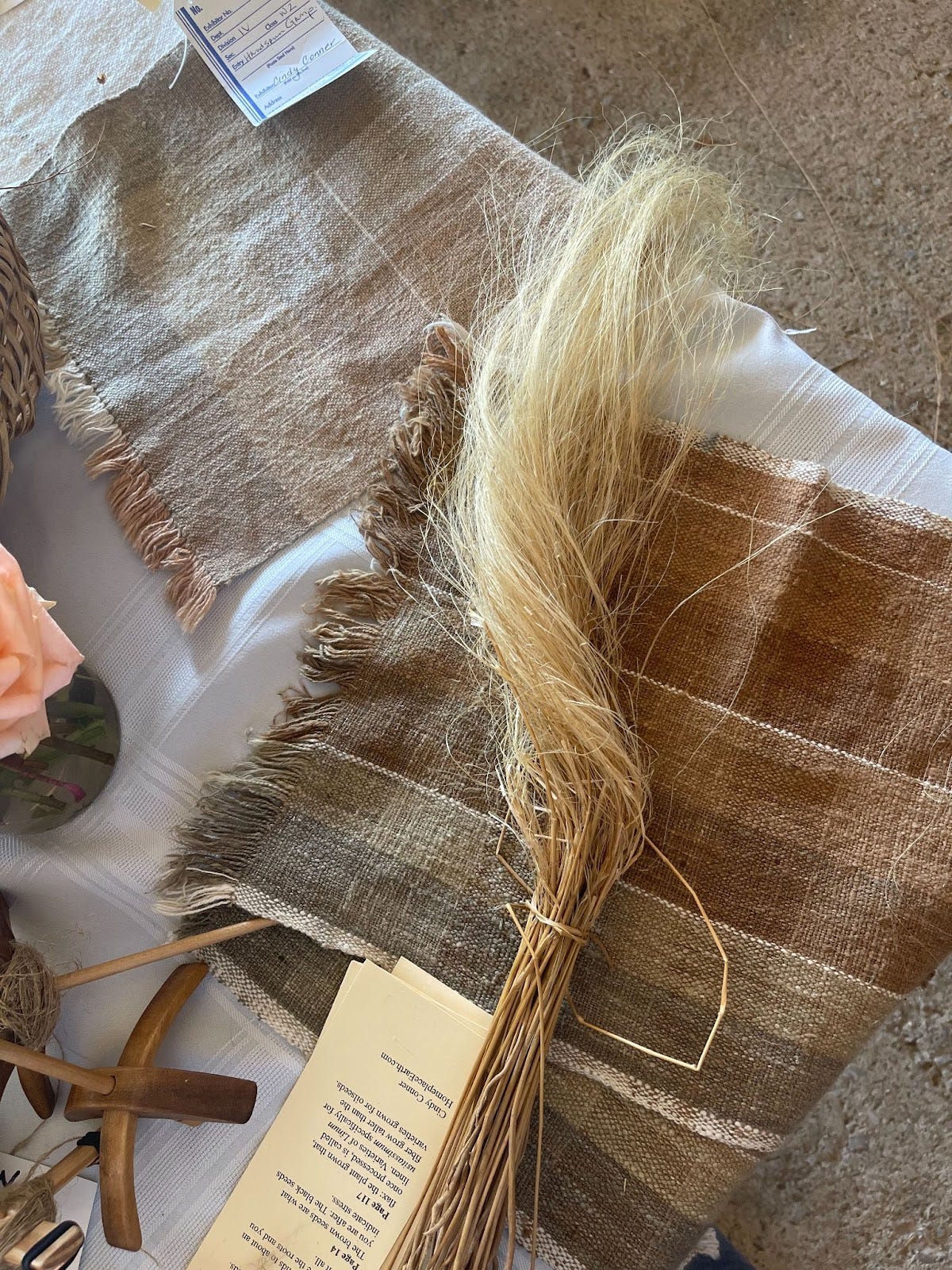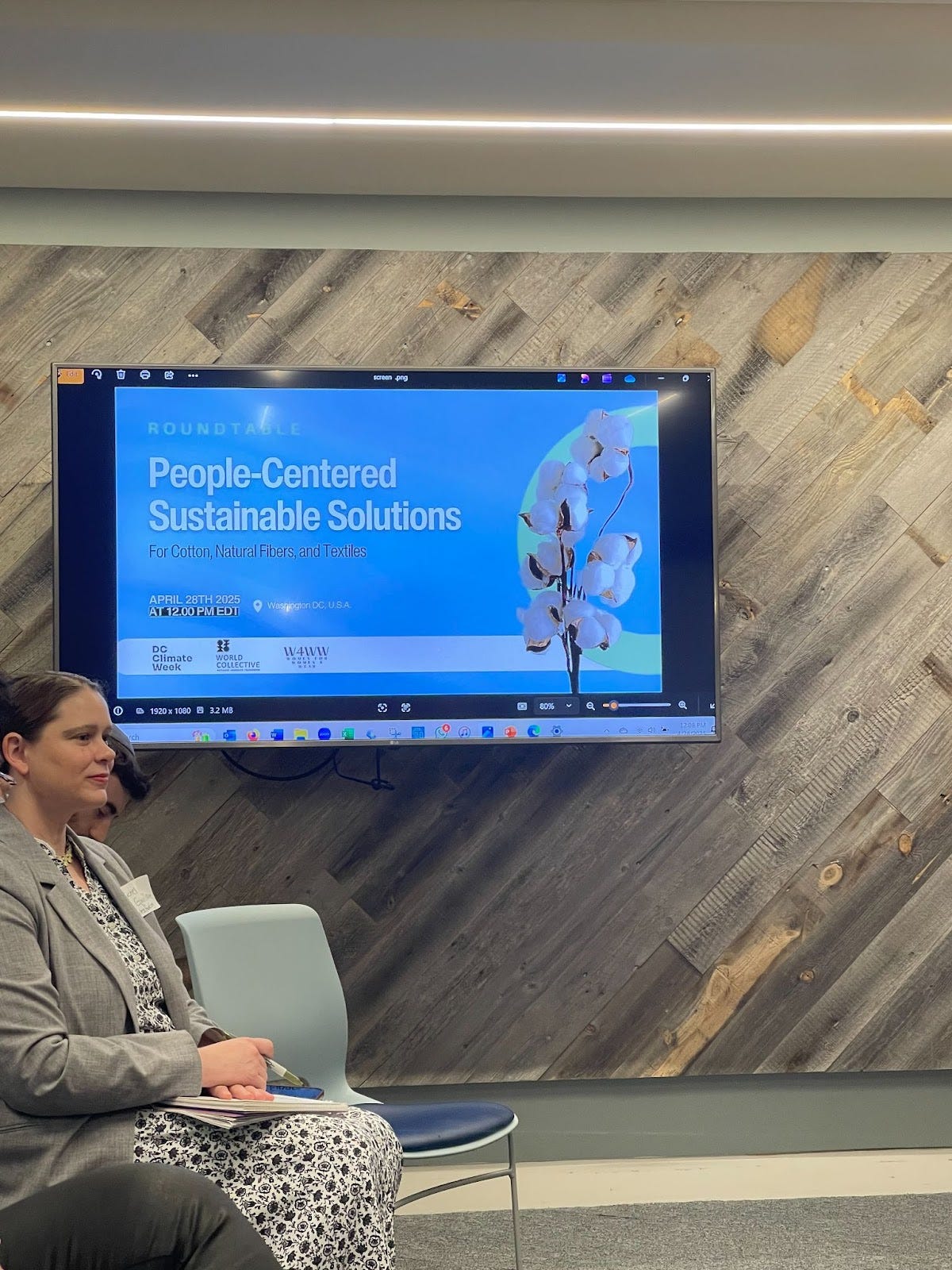"Farm-to-Fiber: Unstitching Plastic from Our Clothes" by Mahima Pande
Hi Friends! This month we're delighted to share this thought-provoking essay by Mahima Pande, a recent RAA alum. Thanks for being part of the Soil Centric community!
I spotted a four-leaf clover at Sky High Farm!
As I walked out of Sky High Farm, one of the many farm sites I visited as part of Climate Farm School’s course in the Hudson Valley, NY, I had an epiphany: What if we brought people to learn about how fiber is cultivated in the same way that we bring people to learn how food is grown? I took this question home with me and began exploring my local fiber network. Joining Soil Centric's latest Regenerative Action Ambassador (RAA) program gave me further incentive to document my insights into the intricate textile supply chain. I decided that my RAA project would involve researching the fast fashion industry, visiting Chesapeake Fibershed, attending DC Climate Week (DCCW), and sharing my findings.
The Fashion Industry currently accounts for 10% of annual greenhouse gas (GHG) emissions, surpassing the combined emissions from all international flights and maritime shipping. Under a business-as-usual scenario, the industry’s emissions are expected to double by 2030. However, the impacts of the current textile supply chain go well beyond carbon, causing nine percent of ocean microplastic pollution! The Fashion Industry is also notoriously known for exploiting labor, two-thirds to three-quarters of whom are women. What if, instead of causing harm, our clothes healed our land and honored the people who made them?
Our clothes could be a carbon sink, but our current textile supply chain is decentralized and disguised. Production happens overseas, where lenient environmental and labor regulations can be taken advantage of. Not only are companies overproducing, but they are also feeding into the vicious cycle of overconsumption through take-back programs, a driver of misleading consumer awareness. Often masked by rewards and discounts, 20-50% of clothing imported through take-back schemes end up in African countries as waste instead of being recycled or reused. Meanwhile, it would be naive to ignore the horrors of raw material extraction for textile production. Polyester, a raw material made of crude oil, accounts for 54% of the fiber production for clothing, and its toxicity is blatant. It’s equally alarming to discover how conventional cotton is also extremely harmful. Recycling enthusiasts may suggest using recycled polyester as it does not incentivize monoculture, require pesticides, and consumes less water than conventionally-grown cotton. However, it is imperative to remember that polyester does not biodegrade, and even recycled polyester, which is made by transforming plastic bottles into fabric, releases microplastics. Eventually, these garments will make their way to the landfill. Ultimately, there isn’t any one specific fiber to blame, but the industry is operating its rapidly growing business as a whole.
If our current textile supply chain is disguised, full of misleading consumer awareness, and incentivizes monoculture, then achieving the inverse would propel us toward the future we want. That is, we can empower connection from “soil to skin” by bringing transparency, raising awareness for positive change, and supporting regenerative fiber producers and farms. To achieve transparency, we must strengthen regional ties that connect farmers, ranchers, artisans, and manufacturers within their respective bioregions. By investing in our local economies, we can build resilience against extractive global systems and pave the path to inclusive prosperity. Transparency from the producers will imbue informed consumer decision-making. As consumers, we need to begin asking questions about the lifecycle of our clothes, such as: Where does this t-shirt come from? Who grew and processed it? How were they treated? What chemicals and/or dyes were used on it? And where will it go when I’m done with it? By thinking about the lifecycle of your garment, you join a much-needed shift. Your purchasing power can support regenerative fiber producers and farms—and help shift your mindset from deficit to abundance.
On this quest to unravel the hidden treasures of my local fiber network, I reached out to Marian Bruno, a fiber artist and committee member of Chesapeake Fibershed. Marian invited me to attend Fall Fest, an in-person gathering featuring a panel discussion on flax production in the mid-Atlantic region, a delicious potluck lunch, and a sustainable fashion show. The panel brought together two prominent figures at the Pennsylvania Flax Project—Heidi Barr, Co-founder and CEO, and Bill Shick, Director of Agriculture—to unveil the hidden value of flax and elaborate on the efforts needed to scale it domestically. Barr pointed out that Northern Europe—France, Belgium, and the Netherlands—and the Baltic States are unable to meet the growing demand for flax, a pest-resistant fiber that needs no fertilizer. This is due to geopolitical tensions, lack of land mass, and economic factors such as changes in subsidies and EU regulations. With over 7 million acres of farmland, Pennsylvania is well-positioned to meet the growing demand for 6,000–8,000 tons of scutched flax fiber—produced by separating bast fibers from woody debris—and 18,000 tons of retted flax straw, generated as flax stems naturally decompose in the field. To incentivize domestic flax production, Shick revealed a potential pipeline: Community Supported Agriculture (CSA), university partnerships, and early-adopter farmers. The PA Flax Project is currently on track to put 4,000 acres of fiber flax into production annually and establish the first cooperatively owned mill in North America by 2028.
I manually processed a flax stalk to uncover its marvelous fibers at the Fall Fest.
Coincidentally, it wouldn’t be the last time I would meet Heidi Barr. At DCCW, we reconnected at the People-Centered Sustainable Solutions for Cotton, Natural Fibers, and Textiles forum. To commence the discussion, Keshav Kranthi, Chief Scientist at the International Cotton Advisory Committee, noted that the world’s 24 million smallholder cotton farms—40 percent women-run—can boost carbon storage by adopting regenerative practices like no-till, addition of biochar, and richer soil microbial diversity. Once cotton is responsibly farmed, Brent Crossland, Founder of 5Loc Cotton, underscored the importance of forging brand–farm partnerships to strengthen our domestic supply chain. Along with investing in American manufacturing, Maine Congresswoman Chellie Pingree called for the need to build resale and reuse infrastructure that shifts landfill costs onto brands. Jeanine Ballone, Founder of World Collective, rounded out the discussion by emphasizing that consumers drive change by insisting on full garment traceability and sharing reliable digital insights to counter misinformation. Participating in this gathering of like-minded, informed individuals, I felt the power of community.
Fiber enthusiasts nerding out :)
Gaining insight into my local fiber network has been part of my ongoing regenerative journey. While easily overlooked, clothes, like food, are a daily part of our lives. We come in contact with them through our skin, the largest organ. The lifecycle of fast fashion contributes to the myriad environmental and social challenges we face. But, I’ve learned that we have the power to nudge brands to make decisions that lead to healthier outcomes, and work with lawmakers to incentivize the creation of regenerative fiber farms. I look forward to the day when farm-to-fiber becomes the norm for our clothes!








very cool to learn about other potential fibers for textiles and communities having the conversations! I love the photo of the fibers from a flax stalk. 🤩 another challenge to fast fashion beyond the sources for clothing and its supply chain is consumers’ expectations for new clothing and the comfort / utility that comes with new, artificial manufactured materials. I think both aspects need to be in conversation together to transform the industry for the better.
Very overlooked agriculture sector! And cotton accounts for a massive amount of pesticide usage globally, too. Hemp and flax are hardy crops that sequester carbon, improve soil, and create high end fibers for textiles and even building materials. I agree that supply chain transparency is a vital component of consumer education - but clothing hyper consumers are often bargain shoppers that are purchasing clothes to fill an internal void that is within by purchasing things. Fast fashion is a nasty beast that will be incredibly difficult to defeat at scale.